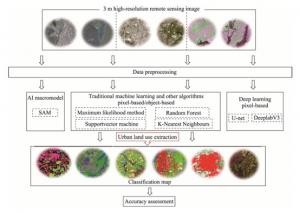Deep learning and beyond: a global test of urban footprint mapping tools
GA, UNITED STATES, June 17, 2025 /EINPresswire.com/ -- Understanding how cities grow is vital for shaping sustainable urban futures—but mapping the true extent of urban expansion remains a formidable technical hurdle. A new global study takes on this challenge by evaluating the performance of various machine learning and deep learning algorithms for extracting urban footprints (UF) from high-resolution satellite images. Analyzing eight diverse cities, the research reveals that while traditional classification methods are fast and accessible, they falter in complex urban settings. In contrast, deep learning and advanced pre-trained models like Segment Anything Model (SAM) offer greater accuracy, albeit with higher computational costs. This comparative analysis provides a crucial guide for selecting the right algorithm to match the unique structure of each urban landscape.
As urban centers become denser and more intricate, traditional tools for land-use monitoring are reaching their limits. The concept of the urban footprint has evolved to include not just concrete structures, but also smaller green spaces and semi-natural features that reflect the livability and environmental quality of cities. Yet, existing extraction techniques often struggle with challenges like shadows from tall buildings, spectral similarities between natural and built environments, and irregular development patterns. The absence of a unified standard for UF definitions further complicates the picture, limiting the comparability of urban studies. Given these issues, there is an urgent need to reassess how UF are detected—especially across varied and evolving urban forms.
In a study published in March 2025 in the Journal of Geographical Sciences, researchers from the University of Aberdeen put several leading UF extraction algorithms to the test. Drawing on PlanetScope’s high-resolution satellite imagery, they evaluated performance across eight cities worldwide—ranging from compact historical hubs to rapidly expanding informal settlements. The team examined traditional pixel-based and object-based classification methods, two deep learning models, and the emerging Segment Anything (SAM) model. Their aim was to measure how well each approach handles the trade-offs between precision, scalability, and operational efficiency in different urban contexts.
The results showed a nuanced performance landscape shaped by urban form and algorithm design. Pixel-based methods such as K-means and Support Vector Machine (SVM) performed adequately in cities with simple, well-defined boundaries but stumbled in areas with high-rise buildings or integrated green infrastructure. Object-based methods improved segmentation through texture analysis but were sensitive to classifier selection, with Random Forest and SVM outperforming others inconsistently. Deep learning models—particularly U-Net and DeeplabV3—achieved the highest overall accuracy, exceeding 90% in most cases. U-Net excelled at capturing fine-grained urban details, while DeeplabV3 offered smoother segmentation in large, noisy urban areas. However, both demanded extensive training and computational power. Meanwhile, the SAM model provided an efficient, user-friendly alternative, outperforming traditional methods and approaching deep learning accuracy in cities with moderate complexity. Yet, SAM’s performance declined in fragmented or irregular urban environments. These findings underscore the need for algorithm selection tailored to specific urban scenarios—and highlight the promise of hybrid approaches that blend traditional and modern techniques.
“Urban morphology varies tremendously from one city to another, so no single model fits all,” said Baoling Gui, the study’s lead author and a PhD candidate in remote sensing and urban geography. “Our findings show that algorithm performance hinges on factors like city layout, density, and the integration of green spaces. While deep learning models deliver exceptional precision, they come at a cost. SAM offers a practical balance between ease of use and accuracy. Understanding these trade-offs is key to designing scalable urban mapping strategies for global applications.”
The implications of this research extend far beyond academic benchmarking. City planners, policymakers, and geospatial analysts can use these insights to build smarter, more responsive monitoring systems for tracking urban growth and managing environmental change. As global cities navigate the challenges of sustainability, resilience, and climate adaptation, accurate and efficient UF mapping becomes a foundational tool. Moreover, the integration of object-based methods into deep learning frameworks could open the door to next-generation hybrid models—ones that offer both high performance and practical flexibility across diverse urban settings.
References
DOI
10.1007/s11442-025-2339-y
Original Source URL
https://doi.org/10.1007/s11442-025-2339-y
Lucy Wang
BioDesign Research
email us here
Legal Disclaimer:
EIN Presswire provides this news content "as is" without warranty of any kind. We do not accept any responsibility or liability for the accuracy, content, images, videos, licenses, completeness, legality, or reliability of the information contained in this article. If you have any complaints or copyright issues related to this article, kindly contact the author above.
The Mortgage Calculator Expands AI Automation to Brokered Loans, Invites MLOs Nationwide to Join Platform
VFS Global expands Indian Consular Application Centres in USA to 16; unveils 8 new centres
Immersive Video Game Attraction 'Dragon Quest Island' Announces New 'Premium All-in-One Ticket'
Więcej ważnych informacji
 Jedynka Newserii
Jedynka Newserii

 Jedynka Newserii
Jedynka Newserii

Konsument

Grupa nowych biednych emerytów stale się powiększa. Ich świadczenie jest znacznie poniżej minimalnej emerytury
Przybywa osób, które z powodu zbyt krótkiego czasu opłacania składek pobierają emeryturę niższą od minimalnej. Tak zwanych nowych biednych emerytów jest w Polsce ok. 430 tys., a zdecydowaną większość grupy stanowią kobiety – wskazują badania ekspertów Instytutu Pracy i Spraw Socjalnych. W ich przypadku krótszy okres składkowy zwykle wynika z konieczności opieki nad dziećmi lub innymi osobami w rodzinie. Wśród innych powodów, wymienianych zarówno przez panie, jak i panów, są także praca za granicą lub na czarno oraz zły stan zdrowia.
Media i PR
M. Wawrykiewicz (PO): Postępowanie z art. 7 przeciw Węgrom pokazało iluzoryczność tej sankcji. Unia wywiera naciski poprzez negocjacje nowego budżetu

Przykład Węgier pokazał, że procedura z artykułu 7 traktatu o UE o łamanie praworządności nie ma mocy prawnej z powodu braku większości, nie mówiąc o jednomyślności wśród pozostałych państw członkowskich. Negocjacje nowego budżetu UE to dobry pretekst do zmiany sposobu części finansowania z pominięciem rządu centralnego. Czerwcowy marsz Pride w Budapeszcie pokazał, że część społeczeństwa, głównie stolica, jest przeciwna rządom Viktora Orbána, ale i na prowincji świadomość konsekwencji działań Fideszu staje się coraz większa przed przyszłorocznymi wyborami.
Firma
Blockchain zmienia rynek pracy i edukacji. Poszukiwane są osoby posiadające wiedzę z różnych dziedzin

Zapotrzebowanie na specjalistów od technologii blockchain dynamicznie rośnie – nie tylko w obszarze IT, ale również w administracji, finansach czy logistyce. Coraz więcej uczelni wprowadza programy związane z rozproszonymi rejestrami, które wyposażają studentów w umiejętności odpowiadające wymogom rynku.
Partner serwisu
Szkolenia

Akademia Newserii
Akademia Newserii to projekt, w ramach którego najlepsi polscy dziennikarze biznesowi, giełdowi oraz lifestylowi, a także szkoleniowcy z wieloletnim doświadczeniem dzielą się swoją wiedzą nt. pracy z mediami.


![Nestlé w Polsce podsumowuje wpływ na krajową gospodarkę. Firma wygenerowała 0,6 proc. polskiego PKB [DEPESZA]](https://www.newseria.pl/files/1097841585/fabryka-nesquik_1,w_85,r_png,_small.png)






.gif)

 |
| |
| |
|